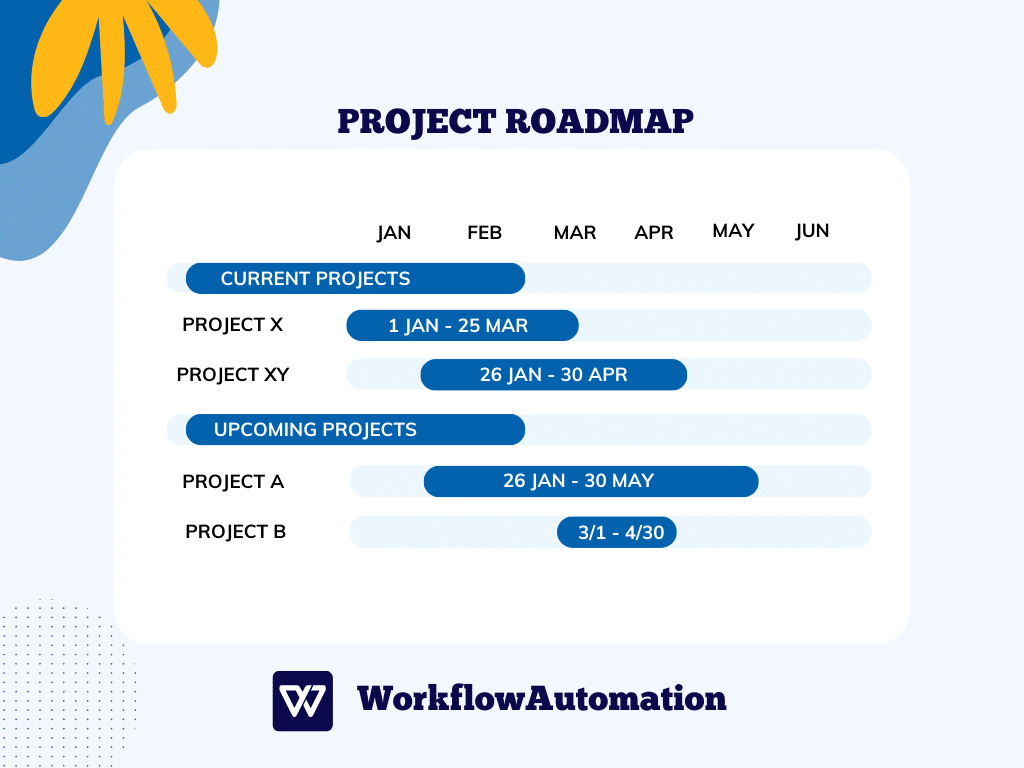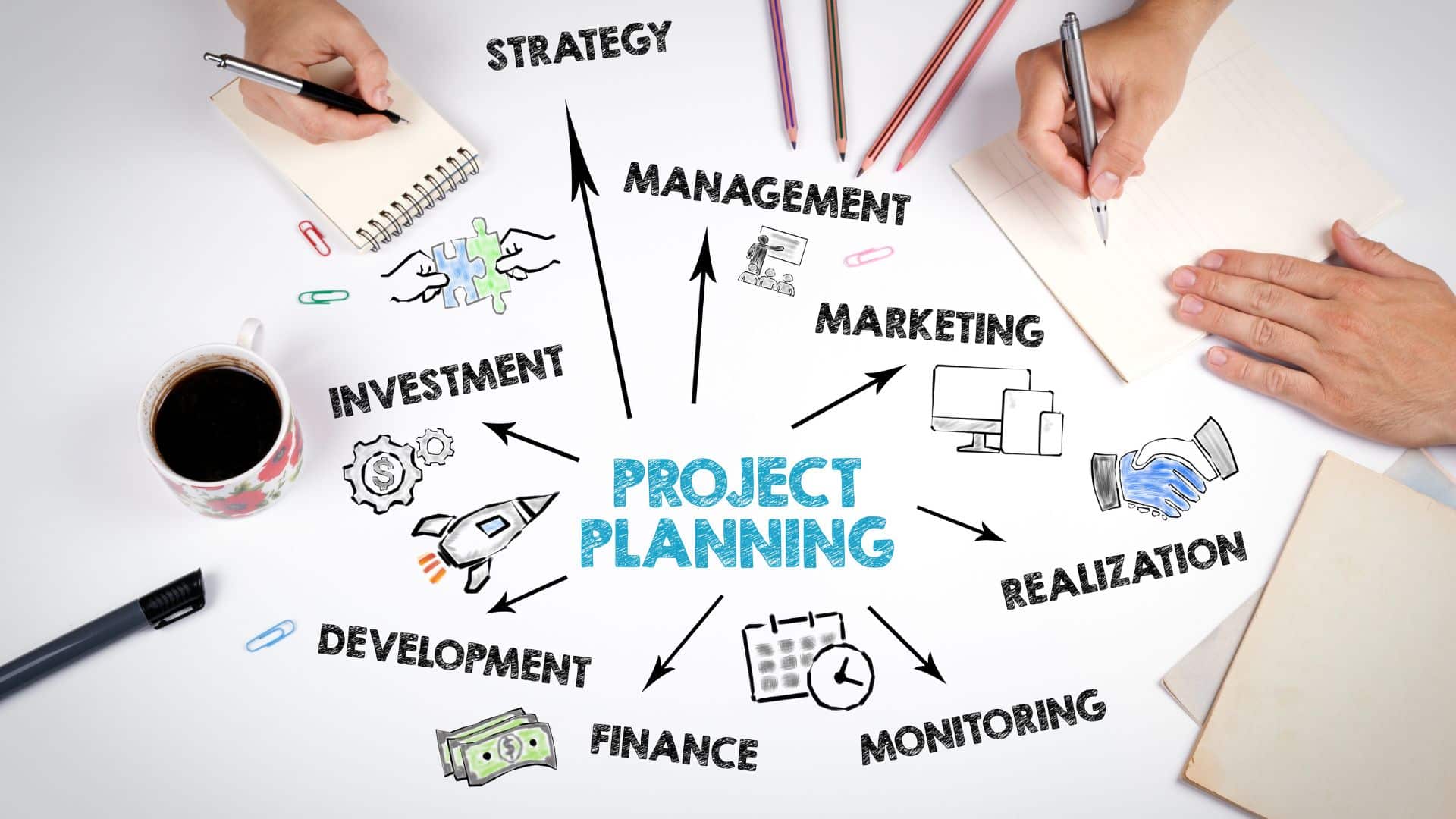Whether planning a project or already working on it, feeling confident about its success is crucial. To ensure a smooth journey and keep that confidence, you can create a project management roadmap.
Think of it as your trusty map, showing you the way and highlighting important stops along the journey. It’s like having a project GPS, helping you and your team know where you are and what’s up ahead.
Let’s explore the concept of a project management roadmap and see how you can make one to guide your project to success!
What is a Roadmap in Project Management?
A roadmap in project management represents a visual and strategic plan that guides the entire project journey from beginning to end, with essential points marked along the way.
This roadmap proves super helpful for project managers and teams as it indicates crucial project milestones that they need to achieve and when they should accomplish them. Meeting these milestones on time means the project is on track.
But it’s not just for the team; project stakeholders also find it essential. They can look at the roadmap to understand the project vision and if it aligns with their requirements. Therefore, a project management roadmap is like a guiding map for everyone involved in the project to stay on the right path and reach the desired destination successfully.
Why Do You Need a Project Management Roadmap?
The project management roadmap consists of the project’s vision and main objectives, milestones, and deliverables.
When team members have it in front of them, you don’t have to worry about them losing sight of the strategic goals and the project’s purpose. It allows them to align every change, circumstance, or factor affecting the project with the project vision.
As mentioned earlier, it is also valuable for stakeholders to have real-time visibility into the project’s progress and the accomplishment of planned milestones, both of which are facilitated by the project management roadmap, without being burdened with details.
Based on this, you can imagine how much easier it is for the project manager to lead the project using the project management roadmap.
Project Roadmap vs. Project Plan
Let’s now solve the project roadmap vs. project plan dilemma and delve into the key differences between them to understand their distinct roles in project management.
So, a project plan is a detailed map that outlines every step and task of the project, providing a detailed view of timelines and responsibilities. It serves as an internal resource, guiding the team through the project’s complexities and helping them stay on track.
In contrast, a project management roadmap is a strategic view highlighting the project’s vision and key milestones. It doesn’t delve into the day-to-day details but offers a visual overview of project progress. A project management roadmap is used to communicate project status to external stakeholders, while a project plan doesn’t.
The two tools work hand in hand, with the project management roadmap setting the direction and presenting the bigger picture, while the project plan provides the actionable steps to reach the milestones.
What Should Be Included in a Project Management Roadmap?
An optimal project management roadmap should include the following elements:
- Project Goals: Identifying goals is crucial to understanding the project purpose and ensuring everyone knows what they are working towards, making sure that there is an alignment with the project’s vision and stakeholders’ needs and requirements.
- Timeline: Establishing specific milestones and project phases and when teams should achieve them helps organize their work efficiently. It enables better tracking of project progress and the accomplishment of its various stages and milestones.
- Risk and Mitigation Strategies: Identifying potential risks and their indicator in different project phases allows for proactive planning. Including mitigation strategies helps minimize the impact of risks on the project’s execution.
- Resources: Listing necessary resources such as personnel, equipment, and funds for each phase ensures smooth progress as the project receives adequate support.
- Roles and Responsibilities: Clearly defining team roles and upcoming responsibilities fosters collaboration. Providing effective communication channels helps teams consult and cooperate, preventing delays caused by misunderstandings.
- Dependencies: Identifying dependencies between tasks and teams helps prioritize activities and avoid potential bottlenecks. Being aware of dependencies aids in timely task prioritization.
- Milestones and Deliverables: Setting clear milestones and deliverables for each project stage acts as checkpoints, facilitating progress tracking and celebrating achievements.
- Change Management: Considering the project’s duration, it’s essential to anticipate changes and have contingency plans. Being flexible and having alternative options ready helps to remain on the original roadmap while successfully adapting to unforeseen circumstances.
How to Create a Project Roadmap
The project management roadmap is a visionary and strategic document that will guide you and your team through the project, so approach it seriously. To create a professional project management roadmap, follow these five steps:
#1. Break Down the Project Into Tasks
Begin by understanding the project’s scope and objectives. Then, divide it into smaller, manageable tasks, where each task should have a clear purpose and contribute to the overall project goal.
For example, imagine you’re leading a software development project. Breaking it down might involve identifying tasks like “User interface design”, “Backend development”, “Testing, and “Deployment”.
#2. Create a Project Timeline
Now that you have your tasks, it’s time to map them out on a timeline. Estimate the duration for each task and consider any external factors or dependencies that might influence the schedule. To make it easy, you can use a project management tool like Gantt charts, which is helpful in visualizing this timeline.
For instance, in the previously mentioned software development project, the “User interface design” phase might take two weeks, followed by “Backend development” for four weeks.
#3. Link Task Dependencies
Some tasks may rely on the completion of others. Identify these dependencies and establish a logical sequence. This ensures smooth progress and prevents bottlenecks.
In the software development project example, “Testing” naturally depends on “Backend development” being completed. Linking these tasks ensures that testing doesn’t begin too early.
#4. Identify Deliverables
Each task should result in tangible or intangible outcomes, which are the project’s deliverables. These deliverables guide your team toward the ultimate project goal, so focus on clearly defining them for each task.
For example, “User interface design” should deliver wireframes and design mockups as tangible results, while “Backend development” may produce a working codebase.
#5. Set up Project Milestones
Milestones are crucial markers of progress. Identify significant points in the timeline, like completing a major phase or achieving key deliverables. They offer a sense of accomplishment and help you track your project’s advancement.
Once you have your project management roadmap ready, share it with the team and stakeholders. Keep it dynamic, allowing for adjustment as the project unfolds. Focus on regularly reviewing and updating the project management roadmap to stay on track.
After this short course, putting together a project management roadmap seems simple. If you still need someone’s help, you can use tools like Monday or Wrike that offer project management roadmap templates.
Benefits of a Project Management Roadmap
The importance of a project management roadmap can be seen through the following benefits:
#1. It Helps With Task Prioritization
One of the primary advantages of a project management roadmap is its ability to aid in task prioritization. By breaking down the project into manageable phases and tasks, the team can first focus on the most critical activities, ensuring efficient resource allocation.
Prioritization prevents teams from getting overwhelmed with multiple tasks, enhancing productivity.
#2. It Clarifies Goals to The Team
A project management roadmap acts as a visual guide, clearly illustrating project goals and objectives to the entire team. When team members understand what needs to be done, they can align their efforts toward the common vision. This promotes collaboration and minimizes the risk of misunderstandings.
#3. It Enhances Communication to the Stakeholders
A project management roadmap enhances communication with stakeholders, both internal and external. Stakeholders remain informed and engaged throughout the project’s lifecycle by presenting a transparent overview of the project’s progress and expected outcomes.
#4. It Facilitates Risk Management
A well-structured project management roadmap enables proactive risk management. The project manager and team can devise appropriate mitigation strategies by identifying potential roadblocks and challenges in advance.
This preparedness ensures that any unexpected hurdles are addressed promptly, minimizing disruptions and enabling project progression.
5 Tips on Creating & Using a Project Roadmap
Here are five essential tips to guide you on how to create and use a project roadmap:
- Use a Template: Save time and ensure all essential elements are included using pre-built project management roadmap templates. Extensively researched and developed, these templates simplify project navigation and management to a tee.
- Collaborate with Stakeholders: Engage with stakeholders while creating the project management roadmap. Align your vision, strategy, and goals with their expectations and desires. This collaborative approach ensures that the roadmap meets the expectations of all parties involved in the project.
- Prioritize Clear Goals: Identify and rank the essential project goals. Prioritize and communicate them clearly to your team, providing a clear direction and focus. This clarity enables team members to understand their expectations and direct their efforts accordingly.
- Set Realistic Timelines: Determine realistic timeframes for project phases, milestones, and deadlines. Creating achievable timelines prevents overload and burnout while informing all stakeholders about the project’s progress.
- Regularly Update and Communicate: Keep the roadmap up-to-date by revisiting and adjusting it as needed. Communicate any changes to all team members and stakeholders to maintain transparency and alignment throughout the project.
Regular updates ensure that everyone is well-informed and on the same page.
Challenges With the Project Management Roadmap
Let’s dive into the common challenges associated with project management roadmaps:
- Lack of Clarity. Setting overly abstract goals can confuse team members and stakeholders. This lack of clarity can result in undefined team roles, decreased motivation, and difficulties in project execution.
- Unrealistic Timelines: Ambitious and unrealistic timelines can cause stress and burnout and compromise the quality of work. This can impede effective project planning and execution, leading to missed deadlines and delayed deliverables.
- Changing Requirements: As projects evolve, requirements and priorities can change. Adapting to these changes is crucial for successful project management. For instance, creating and tracking product goals through a product roadmap can help adjust the project accordingly if there are changes in product features.
- Stakeholder Misalignment: Misalignment with stakeholders’ expectations and objectives can result in conflicts and delays during the project. Regularly engaging with stakeholders and taking their feedback into account enables us to adapt and optimize the project roadmap.
Conclusion
Creating a project management roadmap is essential to ensure team cohesion and efficient progress throughout the project until its completion.
By presenting the project vision, main objectives, and milestones, the project roadmap shows team members in what direction they need to go, what to adhere to, and how to respond to inevitable changes.
On the other hand, a project management roadmap not only empowers project stakeholders with a comprehensive view of the project’s progress but also invites their active participation in its successful execution.
All in all, a project management roadmap is a precious document that will bring many benefits, so approach it carefully and strategically.







